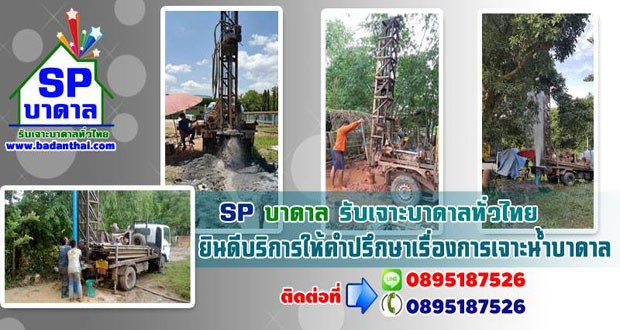
10 ขั้นตอน กว่าจะเป็น “น้ำบาดาล”
หมวดหมู่สินค้า: รวมธุรกิจ SP ONLINE
19 พฤษภาคม 2565
ผู้ชม 312 ผู้ชม
10 ขั้นตอน กว่าจะเป็น “น้ำบาดาล”
1.วิเคราะห์ข้อมูล
- การรวบรวมข้อมูลที่มีอยู่แล้วในฐานข้อมูล
- ข้อมูลน้ำบาดาลที่มีอยู่ทำให้ทราบว่าในพื้นที่นั้นมีบริเวณใดบ้างมีศักยภาพของแหล่งน้ำบาดาลที่ดี
- แผนที่ธรณีวิทยา ทำให้ทราบว่าพื้นที่เป็นหินชนิดใดมีโครงสร้างทางธรณีอย่างไร
- แผนที่แหล่งน้ำบาดาล หรือแผนที่อุทกธรณีวิทยา ทำให้ทราบถึงศักยภาพของแหล่งน้ำฯอย่างคร่าวๆ
- ภาพถ่ายทางอากาศ และภาพถ่ายดาวเทียม ใช้ประกอบรวมกับแผนที่ธรณีวิทยาและแผนที่อุทกธรณีวิทยา
2.สำรวจภาคสนาม
- สำรวจเส้นทางคมนาคมและพื้นที่ที่จะพัฒนา ได้แก่ สภาพหมู่บ้าน ประชากร ฯลฯ
- สำรวจด้านธรณีวิทยา เพื่อให้ทราบชนิดและลักษณะของหิน
- สำรวจด้านอุทกธรณีวิทยา (สภาพแหล่งน้ำบาดาล) ได้แก่ การสำรวจข้อมูลบ่อน้ำตื้น บ่อน้ำบาดาล รวมทั้งแอ่งน้ำธรรมชาติ
- สำรวจด้านธรณีฟิสิกส์ เช่น สำรวจวัดค่าความต้านทานไฟฟ้า สำรวจด้วยคลื่นไหวสะเทือน
3.คัดเลือกสถานที่
-เมื่อผ่านการวิเคราะห์ข้อมูลและแปลความหมายแล้วจะสามารถบอกถึงผลการสำรวจได้
4.เจาะบ่อน้ำบาดาล วิเคราะห์ชั้นดิน/หิน
-ทำให้สามารถคัดเลือกเครื่องจักรเจาะบ่อ ที่เหมาะสมกับชนิดหิน และความลึกของชั้นน้ำบาดาล
5.ออกแบบและก่อสร้างบ่อน้ำบาดาล
6.พัฒนาบ่อน้ำบาดาล
-ในขณะที่เจาะบ่อนั้นมักจะมีน้ำโคลน คราบน้ำมัน ฯลฯ แทรกตัวเข้าไปในชั้นน้ำบาดาล
7.สูบทดสอบปริมาณน้ำบาดาล
- การสูบน้ำออกจากบ่อน้ำบาดาลด้วยอัตราที่กำหนด พร้อมทั้งวัดระดับน้ำที่เปลี่ยน แปลง และจะใช้เวลาสูบต่อเนื่องกันไป ประมาณ 6-72 ชั่วโมง เพื่อประเมินคุณลักษณะของบ่อน้ำบาดาล
- การคำนวณระดับความลึกที่เหมาะสมในการติดตั้งท่อดูดน้ำ
8.วิเคราะห์คุณภาพน้ำ
-การจะนำน้ำบาดาลมาใช้อุปโภค บริโภค ต้องตรวจวิเคราะห์คุณภาพน้ำก่อน ได้แก่ วิเคราะห์คุณสมบัติทางกายภาพ เคมี แบคทีเรีย ตลอดจนสารพิษ ว่าคุณภาพน้ำที่ได้นั้นเป็นอย่างไรหากมีคุณภาพไม่เหมาะสมก็ต้องติดตั้งระบบปรับปรุงคุณภาพน้ำก่อนนำไปใช้ซึ่งสารส่วนเกินที่พบบ่อย คือ สารสะลายเหล็ก แมงกานีส และฟลูออไรด์
9.ปรับปรุงคุณภาพน้ำและออกแบบระบบจ่ายน้ำ
-การปรับปรุงคุณภาพน้ำบาดาล คือ วิธีการทำให้น้ำมีคุณภาพดีขึ้น โดยลดหรือกำจัดสิ่งที่ไม่พึงประสงค์
10.นำไปใช้ประโยชน์
-ในการพัฒนาแหล่งน้ำบาดาลขึ้นมาใช้โดยผ่านขั้นตอนต่างๆ ทางวิชาการน้ำบาดาลหลายขั้นตอนอย่างเป็นระบบ
รับเจาะบาดาล ติดต่อ คุณแอ็ด
10 steps to become "groundwater"
1. Data analysis
- Collection of information that is already in the database
- Existing groundwater data reveals which areas have potential for good groundwater resources.
- Geological map It makes it known that the area is a type of rock and how the geologic structure is.
- Map of groundwater resources or a hydro geological map Makes me know the potential of the water source roughly
- aerial photographs and satellite images used in conjunction with geological maps and hydro geological maps.
2. Field survey
- Explore the transportation routes and areas to be developed such as village conditions, population, etc.
- Geological Survey to know the type and nature of the stone
- Hydro geological survey (The state of groundwater), including surveying information on shallow wells, artesian wells, including natural pools.
- Geophysical surveys such as electrical resistivity surveys seismic survey
3. Select a place
-When the data is analyzed and interpreted, it can tell the results of the survey.
4. Drill an artesian well. Soil/rock analysis
- Makes it possible to select well drilling machines suitable for the type of stone and the depth of the groundwater layer
5. Design and construction of artesian wells
6. Develop an artesian well
-While drilling wells, mud, oil stains, etc. are often infiltrated into the groundwater layer.
7. Pumping to test the amount of groundwater
- Pumping water out of an artesian well at a specified rate. Along with measuring the changing water level, it will take approximately 6-72 hours to continue pumping to assess the characteristics of the artesian well.
- Calculation of the optimum depth for the installation of the suction pipe.
8. Analysis of water quality
- In order to use groundwater for consumption, water quality must be analyzed first, such as analyzing physical, chemical, bacterial, as well as toxic properties, how the water quality is, if it is of inappropriate quality, must install a water quality improvement system before use. Use the most common excess substances are iron, manganese and fluoride dissolved substances.
9. Improve water quality and design a water distribution system.
- Improving the quality of groundwater is a method of improving water quality. By reducing or eliminating unwanted things
10. Take advantage
- To develop groundwater resources through various steps systematic multistage groundwater academic
รับเจาะบาดาล ติดต่อ คุณแอ็ด
成为“地下水”的10个步骤
1. 数据分析
- 收集数据库中已有的信息
- 现有地下水数据揭示了哪些地区具有良好地下水资源的潜力。
- 地质图 它表明该地区是一种岩石以及地质结构如何。
- 地下水资源图或水文地质图让我大致了解水源的潜力
- 航空照片和卫星图像与地质图和水文地质图结合使用。
2. 实地调查
- 探索交通路线和待开发区域,如村庄条件、人口等。
- 地质调查了解石头的类型和性质
- 水文地质调查(地下水状况),包括调查浅井、自流井(包括天然水池)的信息。
- 地球物理调查,例如电阻率调查、地震调查
3. 选择地点
- 当数据被分析和解释时,它可以告诉调查的结果。
4. 钻一口自流井。土壤/岩石分析
- 可以选择适合石材类型和地下水层深度的钻井机。
5.自流井设计与施工
6. 开发自流井
- 打井时,泥浆、油渍等经常渗入地下水层。
7.抽水测试地下水量
- 以指定的速率从自流井中抽水。在测量水位变化的同时,继续抽水以评估自流井的特性大约需要 6-72 小时。
- 计算吸入管安装的最佳深度。
8.水质分析
- 为了使用地下水,必须先分析水质,例如分析物理、化学、细菌、以及毒性特性,水质如何,如果水质不合适,必须安装水质改善装置. 系统使用前。使用最常见地过量物质是铁、锰和氟化物溶解物质。
9.改善水质,设计配水系统。
- 改善地下水水质是改善水质的一种方法。通过减少或消除不需要的东西
10.利用



